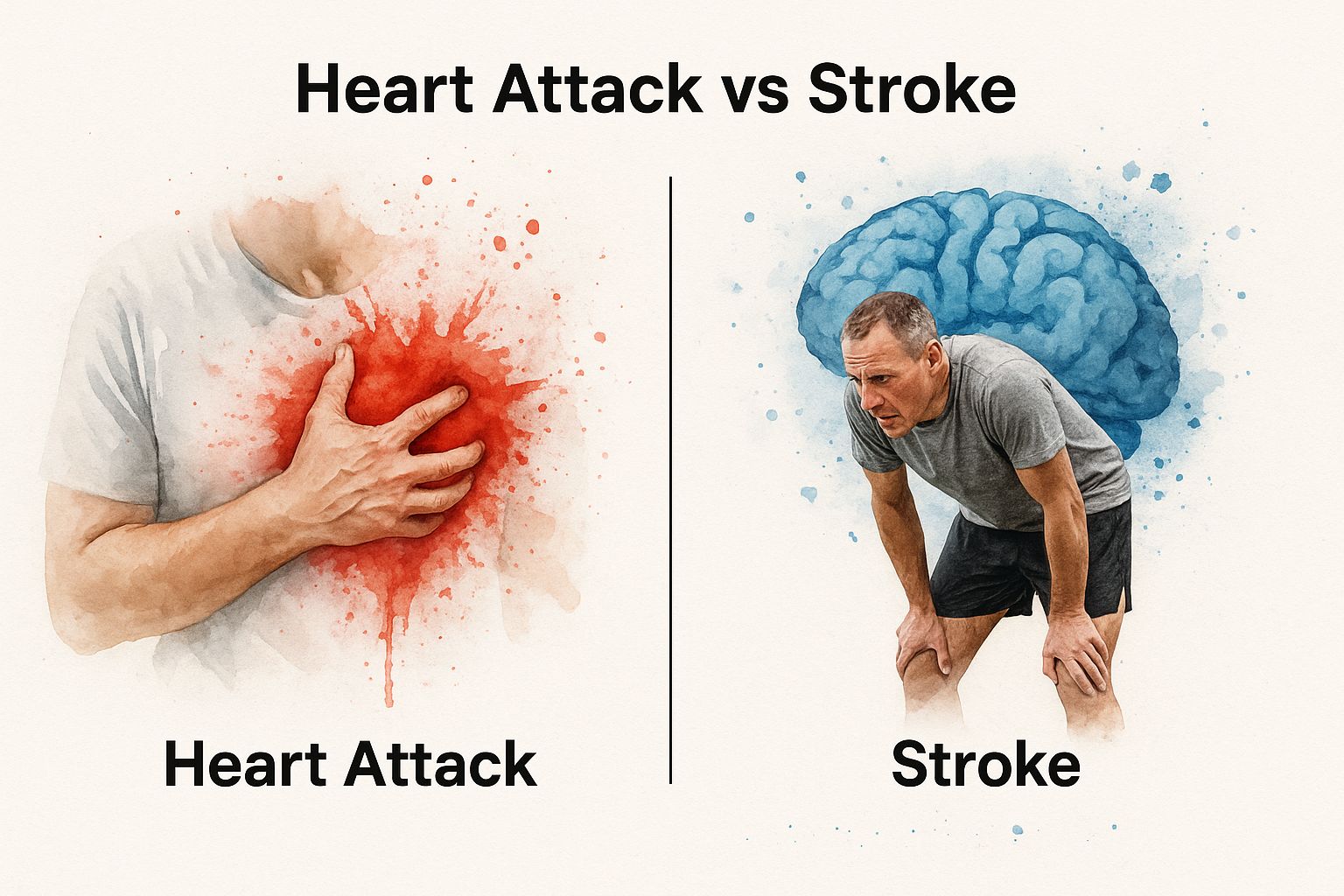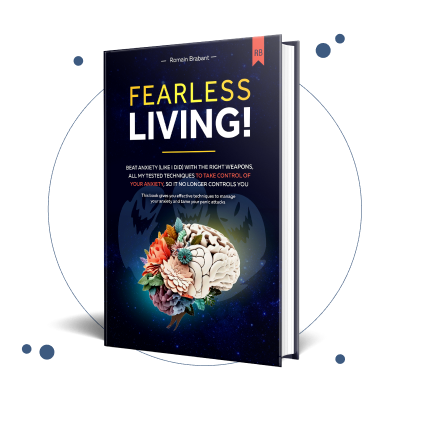
When your heart suddenly starts pounding and your chest tightens, it's easy to fear the worst. The crucial difference between a panic attack vs heart attack is that one is driven by a surge of intense fear, while the other is a life-threatening blockage of blood flow to your heart.
But in the heat of the moment, their symptoms can feel terrifyingly similar. Understanding them is the first step toward not just telling them apart, but also finding a path to living a life free from fear.
Why Panic Attacks and Heart Attacks Feel So Similar
It often starts the same way: a racing heart, sudden chest pain, and a wave of pure, overwhelming fear. That terrifying experience sends your mind spiraling, and you immediately jump to the worst possible conclusion. You're not alone in feeling this way; the confusion is actually rooted in your body's own defense systems.
The overlap in symptoms happens because both events can trigger the same physiological reaction. A panic attack and a heart attack can both kickstart the body’s primal “fight or flight” response, flooding your system with adrenaline. This powerful hormonal surge is designed to prepare you for immediate danger, and it produces very real physical symptoms.
The Role of the Fight or Flight Response
This instinctive survival mechanism doesn’t really distinguish between a perceived threat (like the anxious thoughts that can trigger a panic attack) and a physical one (like a heart attack). As a result, it unleashes a cascade of symptoms that are common to both. You can learn more about how this works in our fight or flight response guide.
This biological response is why you might experience:
- A pounding or racing heart
- Shortness of breath or a feeling of being smothered
- Dizziness, lightheadedness, or feeling faint
- Sweating or chills
- Chest pain or discomfort
The most important rule is to put your safety first. If you are in any doubt about what's causing your symptoms, you must seek emergency medical care immediately. It's always better to be cautious and have a heart attack ruled out by professionals.
Key Initial Distinctions
While we'll get into a deeper comparison, some initial differences can offer a bit of clarity. Panic attacks often hit a peak within minutes and usually start to fade within about 20 minutes. Heart attack symptoms, on the other hand, tend to persist and may even get worse.
This is a critical distinction, especially since approximately 4.7% of adults in the United States will experience panic disorder at some point in their lives. Understanding these nuances is an essential and hopeful step toward managing your anxiety.
| Feature | Panic Attack | Heart Attack |
|---|---|---|
| Onset | Often sudden and can happen even when you're resting. | Can be sudden or start slowly with mild symptoms. |
| Pain Character | Usually sharp, stabbing, and localized in the chest. | Feels like crushing pressure or squeezing; may radiate to the arm, jaw, or back. |
| Duration | Symptoms peak quickly and then begin to subside. | Symptoms are sustained and may intensify over time. |
| Primary Driver | An intense fear and anxiety response. | A physical blockage in a coronary artery. |
A Detailed Comparison of Key Symptoms
Trying to figure out what’s happening in the heat of the moment is tough, but understanding the subtle differences between a panic attack and a heart attack can be incredibly empowering. While both can feel completely overwhelming, the nature, location, and duration of your symptoms often tell very different stories. Moving beyond a simple checklist helps you analyze what your body is actually experiencing.
This visual guide breaks down the distinct physical responses. A panic attack is often driven by the mind's fear response, while a heart attack is a critical medical event happening in the heart.

As the image shows, panic often feels like a desperate gasp for breath, whereas a heart attack is more commonly characterized by a clutching chest. This difference points to the different origins of the distress.
The Character of Chest Pain
Chest pain is the most confusing symptom of all, but how it feels is a major clue. Panic attacks often cause a sharp, stabbing, or localized pain. You might be able to point to a specific spot on your chest that feels like it’s being pricked.
In contrast, the pain from a heart attack is usually described as a deep, crushing pressure or a squeezing sensation. It’s often spread across the chest and feels heavy, almost like something is sitting on you.
How Symptoms Progress and Fade
The timeline of what's happening provides critical information. Panic attack symptoms tend to escalate very quickly, hitting their peak intensity within about 10 minutes. Just as fast as they arrive, they start to fade, and the whole episode is usually over in 20 to 30 minutes.
Heart attack symptoms don't just fade on their own. The discomfort is persistent and can last for an extended period, sometimes intensifying or coming in waves. It won't get better with deep breathing or calming techniques.
To help you sort through the confusion in the moment, here's a quick side-by-side look at how some of the most common symptoms tend to show up differently.
Panic Attack vs Heart Attack Symptom Differentiators
| Symptom | Typical Presentation in a Panic Attack | Typical Presentation in a Heart Attack |
|---|---|---|
| Chest Pain | Sharp, stabbing, and often localized. You can usually point to a specific spot. | A deep, crushing pressure or squeezing sensation that feels widespread across the chest. |
| Onset | Abrupt and intense, peaking within 10 minutes. | Can be sudden, but often starts gradually and persists or worsens over time. |
| Duration | Symptoms typically fade and the episode is over within 20-30 minutes. | Symptoms do not resolve on their own and can last for an extended period. |
| Pain Radiation | Discomfort usually stays centered in the chest. | Pain often radiates from the chest to the left arm, jaw, neck, shoulders, or back. |
| Breathing | A feeling of breathlessness or hyperventilation; often feels like you can't get enough air. | Shortness of breath that can occur with or without chest discomfort. |
| Other Sensations | Tingling or numbness in hands, feet, or face due to changes in breathing. | May be accompanied by cold sweats, nausea, or lightheadedness. |
Keep in mind that these are typical presentations, and everyone's experience can be different. The key is to look at the overall pattern of symptoms, not just one in isolation.
Radiation of Pain and Other Sensations
Where the pain travels—or doesn't—is another significant sign.
- Panic Attack: The discomfort usually stays put in the chest. You might also feel tingling or numbness in your hands, feet, or face, which is often a result of hyperventilation.
- Heart Attack: A classic sign is pain that radiates from the chest to other areas, most commonly the left arm, jaw, neck, shoulders, or back.
A sense of impending doom is common in both, but during a panic attack, this fear is often the cause of the physical symptoms. In a heart attack, the intense fear is a reaction to the severe and unrelenting physical pain.
Understanding these differences is a powerful step toward managing your health. While a panic attack isn't life-threatening, it is a very real and distressing experience that points to an underlying issue. Many people find that learning to identify the patterns of their symptoms is a crucial part of managing various anxiety disorders and dialing down the fear of the next episode.
Remembering that you can learn to manage these feelings is the first step toward a life that isn't ruled by fear. This knowledge isn't just about telling the two events apart; it's about reclaiming your peace of mind.
Understanding Your Triggers and Risk Factors
Knowing why this is happening is the first step toward getting back in control. When you can tell the difference between what triggers a panic attack and what puts you at risk for a heart attack, that terrifying confusion starts to lift.
This isn't just about knowledge; it's about empowerment. It lets you focus on the right kind of preventative care—whether that’s for your mental well-being or your physical health.
What Sparks a Panic Attack?
Panic attacks can feel like they strike out of nowhere, but they're often the result of an internal alarm system going haywire. Your body’s ‘fight or flight’ response gets triggered not by a real, immediate danger, but by psychological or physiological stress that's been building up.
While the specific causes are deeply personal, they usually fall into a few key areas:
- Chronic Stress: Think of your nervous system like a car engine that's been revving too high for too long. Constant pressure from work, relationships, or money troubles leaves you perpetually on high alert, making it much easier to tip over into panic.
- Significant Life Changes: Big shifts like losing a job, moving to a new city, or grieving a loved one can overwhelm your ability to cope, creating the perfect storm for a panic attack.
- Genetics and Brain Chemistry: Sometimes, it's in your wiring. A family history of anxiety or panic disorder can make you more susceptible.
Figuring out your own unique triggers is foundational to managing anxiety. For a deeper look, you can explore some of the most common anxiety triggers and see which ones feel familiar.
Understanding this is key: a panic attack is a reaction to a perceived threat, not an actual one. Your body is doing its job—trying to protect you. Your mind just needs some new tools to help it tell the difference between real danger and a false alarm.
Heart Attack Risk Factors
In sharp contrast, the risk factors for a heart attack are purely physiological. They’re not about a misfiring alarm system; they're about the long-term health of your heart and arteries.
These are well-known medical conditions that put a strain on your cardiovascular system over months and years, making a blockage much more likely.
Key risk factors include:
- High Blood Pressure (Hypertension): This forces your heart to work overtime, which can damage and weaken your artery walls.
- High Cholesterol: Excess cholesterol can build up as plaque inside your arteries, narrowing the path for blood to flow.
- Smoking: This is a major one. It directly damages blood vessels and is a massive contributor to heart disease.
- Diabetes: Over time, high blood sugar can damage the arteries and nerves that control your heart.
- Family History: A genetic predisposition can significantly elevate your risk, even if you have a healthy lifestyle.
When you separate these two very different sets of causes, you can get a clearer picture of your personal risk profile. If your medical history and lifestyle tick the boxes for cardiovascular risk, chest pain is a clear signal to seek immediate medical help.
But if you recognize the patterns of stress and anxiety in your own life, you can feel hopeful. There are powerful, effective ways to manage panic and get back to feeling like yourself.
The Link Between Long-Term Anxiety and Heart Health
While a single panic attack won't cause a heart attack, we can't ignore the deeper connection between chronic anxiety and the long-term health of your heart. This isn't about adding another layer of fear to what you're already feeling. It's about validating the very real, physical toll of persistent stress and showing you that managing anxiety is one of the most powerful things you can do for your physical future.

When you're living in a constant state of high alert—something all too common with panic disorder—your body is frequently flooded with stress hormones like adrenaline and cortisol. Over time, keeping your system in this sustained "fight or flight" mode can put a serious strain on your entire cardiovascular system.
How Chronic Anxiety Affects Your Heart
When your body is constantly primed for danger, it can trigger physical changes that quietly increase your risk of heart problems down the road. This is precisely why getting to the root of your panic isn't just a mental health priority; it’s a physical one, too.
Chronic anxiety can contribute to:
- Elevated Blood Pressure: The nonstop release of stress hormones can keep your blood pressure consistently high, forcing your heart to work much harder than it should.
- Increased Heart Rate: A heart that’s always racing can, over many years, lead to wear and tear on the heart muscle itself.
- Inflammation: We now know that long-term stress is directly linked to increased inflammation throughout the body, which is a major risk factor for heart disease.
This connection isn't just theoretical. Medical research consistently finds links between panic disorder and specific heart issues. Studies have shown that people with panic disorder may be more likely to have certain heart abnormalities, like elevated standing heart rates and arrhythmias. In fact, roughly 10% of patients with panic disorder also experience arrhythmias. Panic disorder has even been associated with changes in the heart's structure and higher levels of stress markers in the blood. You can dive deeper into the link between anxiety and cardiac health on pmc.ncbi.nlm.nih.gov.
There Is Hope for Healing
Reading this might feel overwhelming, but it should actually give you a profound sense of hope. It validates that what you’re experiencing is real and has a physical basis. More importantly, it points to a clear path toward protecting your heart: managing your anxiety.
By seeking treatment for panic and anxiety, you are not only reclaiming your mental peace but also making a powerful, proactive investment in your long-term cardiovascular health.
Healing from anxiety is absolutely possible. With the right support and tools, you can calm your nervous system, slash the frequency and intensity of panic attacks, and reduce the physical strain on your body. This journey is about moving from a state of constant fear to one of empowerment, where you can live a full life without the shadow of panic.
The path to a panic-free life is also a path to a healthier heart.
What to Do When Symptoms Strike
When a wave of terrifying symptoms hits—chest pain, a racing heart, a feeling of doom—your mind can go blank. In that moment of pure fear, it's critical to have a clear plan. You need simple, actionable steps that prioritize your safety above all else.
The single most important rule is this: when in any doubt, call for emergency help immediately. If there’s even a sliver of a chance you’re having a heart attack, waiting is a risk you can't afford to take. Medical professionals are the only ones who can definitively rule out a cardiac event. It is always, always better to be safe and get checked out.
First Response When Symptoms Appear
Once you’ve called for help or a doctor has given you the all-clear, you can shift your focus. If you're dealing with a panic attack, the next step is to gently guide your body out of its intense fear response. There are proven strategies that can help you ride out the wave of anxiety.
The goal here isn't to fight the sensations but to signal to your nervous system that you're not in real danger, even though every part of you feels like you are.
Grounding and Breathing Techniques
Focused breathing is one of the quickest ways to hit the brakes on the panic cycle. During a panic attack, breathing becomes shallow and fast, which just amps up the dizziness and fear. By deliberately slowing down your breath, you send a powerful message back to your brain: calm down. For specific methods, check out our guide to breathing exercises for anxiety.
Next, try a grounding exercise. This pulls your attention away from the internal storm and anchors you in the present moment. The 5-4-3-2-1 method is a go-to for a reason—it’s simple and it works.
- 5: Name five things you can see around you.
- 4: Notice four things you can touch.
- 3: Listen for three sounds you can hear.
- 2: Identify two different smells.
- 1: Name one thing you can taste.
This little exercise forces your brain to switch gears, moving from abstract fear to concrete, sensory details. It breaks the feedback loop that fuels panic and reminds you that, in this very moment, you are safe.
These aren't just quick fixes; they're the first steps on the path to taking back control. Learning to navigate these terrifying moments builds real confidence. It proves that a life free from the constant fear of panic isn't just a dream—it's entirely possible.
Your Path to Living Without Fear of Panic
Living with the constant worry of a panic attack vs heart attack can feel like you're trapped under a dark cloud. Every strange flutter in your chest or shortness of breath can send a wave of terror through you. But it's so important to grasp this one powerful truth: panic disorder is highly treatable. A life without this constant fear isn't just a fantasy—it's a real, achievable goal, and you've already got the strength to start that journey.

The path forward is paved with proven, evidence-based strategies that have helped millions reclaim their lives from anxiety's grip. The very first step is simply recognizing that you don't have to figure this out alone. Getting professional support can give you the tools and guidance to finally dismantle the cycle of panic.
Finding the Right Treatment for You
Effective treatment usually involves a mix of therapy and, in some cases, medication. The goal isn't just to quiet the symptoms but to get to the very root of the panic response, essentially retraining your brain to understand that it’s not in real danger.
Some of the most powerful approaches include:
- Cognitive Behavioral Therapy (CBT): This is considered the gold standard for treating panic disorder. A therapist helps you pinpoint and challenge the terrifying thoughts that kick off the panic, slowly replacing them with more balanced and realistic ones.
- Exposure Therapy: This involves safely and gradually exposing yourself to the physical sensations of panic in a controlled setting. It’s a way to teach your brain that these feelings, while incredibly uncomfortable, are not actually dangerous.
- Medication: Certain medications can be a game-changer for reducing the frequency and intensity of panic attacks. They're often used alongside therapy to create stability while you're learning new coping skills.
Recovery is a process of learning to trust your body again. It’s about understanding that even when the alarm bells of panic go off, you have the tools to turn them down and find your calm.
Globally, heart attacks are a leading cause of death, with cardiovascular diseases accounting for roughly 17.9 million deaths each year. Panic attacks, on the other hand, are not life-threatening, but they can severely cripple your well-being. Both conditions put a huge strain on people and healthcare systems, which is why getting the right care for the right condition is so vital. You can get more insights on distinguishing these conditions from the American Heart Association.
By taking these proactive steps, you begin to shift from a place of fear and uncertainty to one of empowerment. You can learn more about how psychotherapy for anxiety provides a structured path toward healing. Just remember, every single step you take to manage panic is a step toward a brighter, more peaceful future.
Got Questions? Let's Clear Things Up
When you're trying to tell the difference between a panic attack and a heart attack, a lot of questions can come up. It’s a scary topic, and getting clear answers can make all the difference. Here’s what people often ask.
Can You Have a Panic Attack and a Heart Attack at the Same Time?
This is a big one, and the short answer is: it's incredibly rare, but theoretically possible. Think of it this way—the massive stress from a panic attack could potentially trigger a cardiac event, but only in someone who already has severe, pre-existing heart disease.
For most healthy people, this isn't a primary concern. The real takeaway here is simple: never ignore chest pain. Always get it checked out by a medical professional to rule out a heart issue first.
If I Have Frequent Panic Attacks, Will I Have a Heart Attack?
This is a common fear, but having panic attacks doesn't directly cause heart attacks. They are separate events.
However, living with chronic stress and anxiety can contribute to the risk of developing heart disease over the long term. Think of managing your anxiety as a proactive step for both your mind and your heart. Getting a handle on it with therapy and lifestyle changes is a powerful way to invest in your future health.
Remember, treating anxiety is a powerful way to invest in your long-term heart health. A calmer mind contributes to a calmer, healthier body, showing that a life free from panic is entirely within reach.
How Long Do the Symptoms Actually Last?
This is probably one of the clearest ways to tell the two apart.
Panic attack symptoms hit hard and fast, usually peaking within 10 minutes. After that, they start to fade, and the whole episode is typically over within 20-30 minutes.
Heart attack symptoms, on the other hand, don't just go away. The pain and discomfort are persistent, stick around, and can even get worse over time. They won't resolve on their own and demand immediate medical help.
At The Anxiety Checklist, we believe that a life free from the constant fear of panic is not just a dream—it's an achievable reality. Our Fearless Living system provides the practical tools and cognitive strategies to help you manage anxiety, understand your triggers, and regain control. Start your journey toward lasting peace of mind and learn more at AnxietyChecklist.com.

